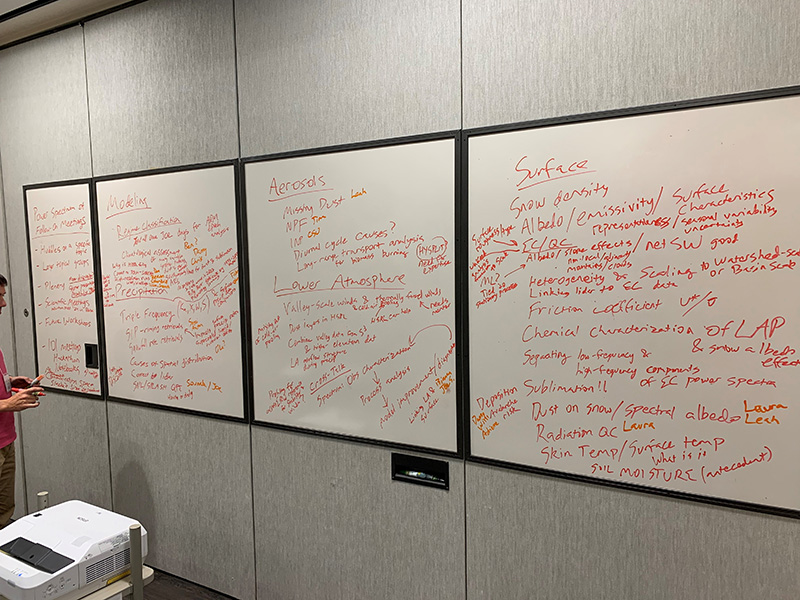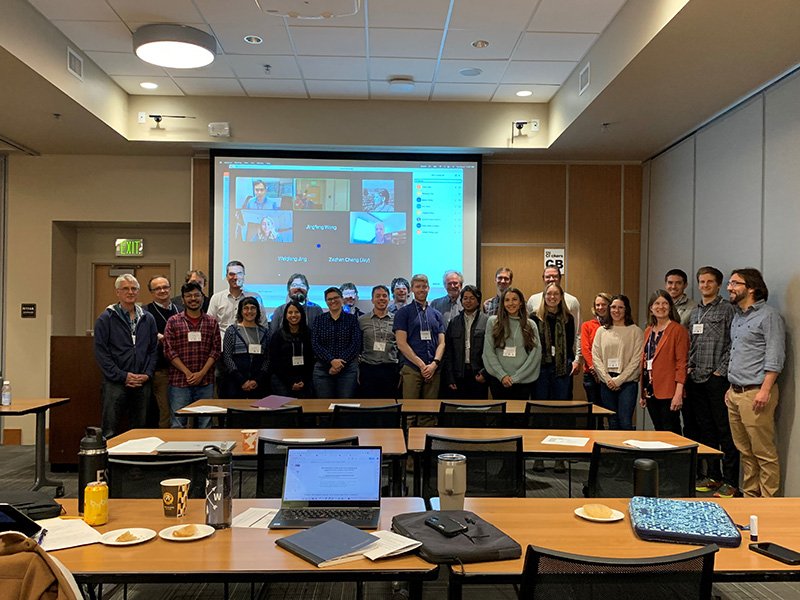Editor’s note: Gijs de Boer, an atmospheric scientist from the University of Colorado’s Cooperative Institute for Research in Environmental Sciences and the National Oceanic and Atmospheric Administration (NOAA) Physical Sciences Laboratory in Boulder, Colorado, wrote the following synopsis of a November 1–3, 2023, hybrid workshop on the state of research and data sets from the Study of Precipitation, the Lower Atmosphere and Surface for Hydrometeorology (SPLASH); the Surface Atmosphere Integrated Field Laboratory (SAIL) campaign; and the Sublimation of Snow (SOS) study.

One day after a cold, snowy Halloween celebration on Colorado’s Front Range, a team of 80 scientists gathered virtually and in person at the University of Colorado Boulder to talk about current and future research in connection with recently completed fieldwork in the Colorado Rockies.
With dwindling water supplies in the Colorado River, one of the most impactful river systems in the world, the team’s mission is to help answer questions on the drivers of water availability in the East River Watershed, one of the important headwater regions of the Upper Colorado River. From precipitation through surface processes, many factors govern the ultimate transfer of rain and snow into the streams that eventually join to form the mighty Colorado River. Despite the importance of Colorado River water to the livelihoods of people in the Western United States and the region’s ability to provide food to the rest of the planet, comprehensive extended-duration studies of key physical processes have been limited, resulting in suboptimal performance of weather and water prediction systems across a variety of time scales.
To help shed new light on some of the major drivers of uncertainties in these models, the following trio of field campaigns took place in the Colorado Rockies over a two-year window from September 2021 to October 2023:
- SPLASH, supported by NOAA
- SAIL, supported by the U.S. Department of Energy (DOE) and built around a mobile facility deployment conducted by the Atmospheric Radiation Measurement (ARM) user facility
- SOS, funded by the National Science Foundation.
Collectively referred to as S3, these campaigns together made detailed measurements of precipitation processes, lower atmospheric structure, exchange of energy between the surface and atmosphere, surface properties, and aerosol particles across a transect of approximately 30 kilometers (about 19 miles). In addition, these campaigns included deployments of additional assets, including ARM’s tethered balloon system, NOAA and Airborne Snow Observatory aircraft, and uncrewed aircraft systems, to gain detailed perspectives on spatial heterogeneities in the area.
Developing an S3 Community

Only a week or so after the final data came in from this trio of campaigns, the S3 Workshop—co-organized by Gijs de Boer (University of Colorado Boulder), Dan Feldman (Lawrence Berkeley National Laboratory), and Jessica Lundquist (University of Washington)—brought together the campaign teams to talk data, find common ground on research themes, and learn about ongoing work and desired outcomes.
Developing collaborations across the S3 community was a primary focus of this initial workshop. Such collaborations are particularly valuable given that each campaign has slightly different (though ultimately closely related) goals and foci, and to help bridge work supported by a variety of agencies, programs, and laboratories.
Following a welcome and logistical introduction from local host de Boer and a social meet and greet, participants got overviews of the three projects from principal investigators de Boer (SPLASH), Feldman (SAIL), and Lundquist (SOS). This was followed by an introduction to the primary meeting objectives, which included building relationships, sharing information, and developing next steps.
With a primary driver of S3-related research being the ultimate improvement of weather, water, and climate prediction tools, it was only natural to kick off the scientific portion of the workshop with a session on modeling efforts. The session included seven presentations on parameterization development, process studies, model evaluation, and more, followed by a group discussion. The integration of modeling and observational analyses is a significant strength and vital element of all three of the S3 campaigns.
Diving Into Data to Understand Mountain Weather and Water

After an evening social event that linked S3 teams with other Boulder scientists interested in water-related research, Day Two sessions were focused on data and the science that these measurements are helping to inform.
The day started with seven detailed presentations providing overviews of the data sets collected by the S3 teams and related efforts. Subsequent discussion included conversations about data sharing, data papers, and how to best alert the broader community to the availability of these rich data sets.
This data session was followed by scientific sessions on four topical areas: precipitation, aerosol processes, the lower atmospheric state, and the surface energy budget. These sessions featured presentations and open discussion on work required in each topical area. It was clear from these sessions that the extensive data sets collected will offer the basis for extended analysis of atmospheric and surface processes over complex terrain for years to come.
In total, 26 presentations were given between the different campaigns, and several connections were made between presenting teams.
An additional important topic discussed was how the S3 community could best connect with other efforts focused on the East River Watershed and Colorado River, including the DOE-supported Watershed Function Scientific Focus Area, led by Lawrence Berkeley National Laboratory.
Progress, and What’s Next
Want to get involved? Community members interested in learning more about the S3 projects and associated data sets are welcome to contact Gijs de Boer.
Even in the short time since S3 data collection ended, a great deal of progress toward answering important questions about mountain weather and water has already been made.
The workshop concluded following an extensive discussion and identification of several opportunities for collaboration, needs, and next steps. In addition to general needs related to meeting coordination, and development of special collections in scientific journals to highlight publications related to S3 data and science, there was significant conversation about scientific prioritization. Those discussions naturally broke down among several key categories, including modeling, precipitation, aerosols, the lower atmosphere, the surface, and interfaces between these different elements.
Both SAIL and SPLASH have already seen project summaries published in the Bulletin of the American Meteorological Society (BAMS), and an SOS summary article is advancing toward publication. These articles will be some of the many anticipated to be part of a special collection across journals of the American Meteorological Society (AMS), as well as an envisioned special issue of the Earth System Science Data journal.
In addition to reconnecting at the AMS and American Geophysical Union (AGU) annual meetings, the S3 community is working to develop follow-on workshops in the coming year. The team also plans to have significant representation at the next Joint ARM User Facility/Atmospheric System Research (ASR) Principal Investigators Meeting.
While just a starting point, the S3 Workshop was a terrific success. It served as a spark for several new collaborations necessary to answer important questions on water in the Mountain West and processes governing weather and climate in areas of complex terrain.

